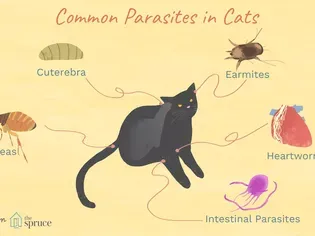Worms, Mites, Ticks and Other Bugs That Live on Cats
Updated on 04/26/24

Worms, Mites, Ticks and Other Bugs That Live on Cats: A Comprehensive Guide
As a responsible cat owner, it's crucial to be aware of the various parasites and pests that can affect your feline companion. From microscopic worms to pesky mites and blood-sucking ticks, these unwelcome guests can cause discomfort, health problems, and even spread diseases to both cats and humans.
In this comprehensive guide, we'll delve into the world of worms, mites, ticks, and other bugs that live on cats. We'll explore their life cycles, transmission methods, signs and symptoms, and effective treatment and prevention strategies.
Roundworms:
Roundworms are the most common type of intestinal parasite in cats. These long, thin worms reside in the digestive tract, where they feed on the cat's food and nutrients. Symptoms of roundworm infection include weight loss, poor appetite, vomiting, diarrhea, and a pot-bellied appearance.
Tapeworms:
Tapeworms are flat, segmented parasites that attach themselves to the lining of the cat's digestive tract. They absorb nutrients from the cat's food, leading to weight loss and malnutrition. Segments of tapeworms may be visible in the cat's feces or on the fur around its anus.
Hookworms:
Hookworms are small, slender worms that attach themselves to the lining of the cat's small intestine. They feed on the cat's blood, causing anemia, weakness, and weight loss. Heavy hookworm infections can be life-threatening, especially in kittens.
Whipworms:
Whipworms are thin, thread-like worms that reside in the cat's large intestine. They cause diarrhea, straining during defecation, and weight loss. Whipworm eggs are very resistant to environmental conditions, making them difficult to eliminate.
Mites:
Mites are tiny, eight-legged creatures that can infest cats' ears, skin, and respiratory system. Ear mites cause intense itching, head shaking, and a dark, crumbly discharge in the ears. Skin mites can cause severe itching, hair loss, and crusty lesions. Respiratory mites can lead to sneezing, coughing, and difficulty breathing.
Ticks:
Ticks are external parasites that attach themselves to the skin of cats. They feed on the cat's blood, causing irritation, anemia, and the transmission of diseases such as Lyme disease and Rocky Mountain spotted fever.
Fleas:
Fleas are small, wingless insects that infest cats' fur. They feed on the cat's blood, causing itching, irritation, and hair loss. Fleas can also transmit tapeworms to cats when they are ingested during grooming.
Other Parasites:
In addition to the common parasites mentioned above, cats can also be affected by less common parasites such as:
* Coccidia: Microscopic parasites that cause diarrhea in cats, especially kittens.
* Giardia: A protozoan parasite that causes intermittent diarrhea.
* Demodex mites: Skin parasites that cause hair loss and crusty lesions.
* Scabies mites: Skin parasites that cause intense itching and hair loss.
Prevention and Treatment:
Preventing and treating parasites and pests in cats requires a multifaceted approach. Regular veterinary check-ups, deworming, and flea and tick control are essential. Maintaining good hygiene, such as regularly cleaning litter boxes and bedding, can also help reduce the risk of infestation.
* Deworming: Cats should be dewormed regularly, starting at two to four weeks of age. Dewormers kill intestinal parasites, such as roundworms, tapeworms, and hookworms.
* Flea and Tick Control: Use topical flea and tick prevention products, such as spot-on treatments or collars, to kill and repel these parasites.
* Ear Mite Treatment: Ear mites are treated with topical or oral medications prescribed by a veterinarian.
* Skin Mite Treatment: Skin mites are treated with topical medications, such as shampoos or ointments.
* Tick Removal: If a tick is found on your cat, remove it immediately with a tick removal tool.
* Coccidia Treatment: Coccidia is treated with antiprotozoal medications prescribed by a veterinarian.
* Giardia Treatment: Giardia is treated with antibiotics prescribed by a veterinarian.
* Demodex Mite Treatment: Demodex mites are treated with topical or oral medications prescribed by a veterinarian.
* Scabies Mite Treatment: Scabies mites are treated with topical or oral medications prescribed by a veterinarian.
Conclusion:
Understanding the different worms, mites, ticks, and other bugs that live on cats is crucial for protecting your feline friend's health and well-being. By following proper prevention and treatment strategies, you can minimize the risk of infestation and ensure your cat enjoys a healthy, parasite-free life.
Explore More Pets

Cat Behavior Problems
How to Stop Aggression in Kittens

Long-Haired Cat Breeds
Siberian Cat: Breed Profile, Characteristics, & Care

Cat Behavior Problems
How to Stop Kittens From Scratching and Biting

Long-Haired Cat Breeds
Turkish Angora: Cat Breed Profile, Characteristics & Care

Basic Training
How to Socialize Your Kitten

Short-Haired Cat Breeds
Cute Pictures & Facts About Calico Cats & Kittens

Litter Box Training
Training Your Kitten to Use the Litter Box

Long-Haired Cat Breeds
10 Fun Facts About White Cats